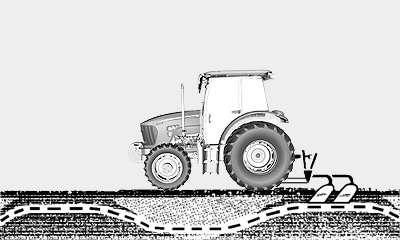Ballast Calculation for Optimum Performance

CQ294945-UN-29NOV13
We are using a tractor with the following configuration as example:
Four front weights of 50 kg
Two rear weights of 55 kg
Two rear weights of 38,5 kg
Front tire 12.4-24
Rear tire 18.4-30
Weight on the scale:
Front weight 1450 kg
Rear
weight 1720 kg
Implement mounted to center link: 40x60 distribution
(previous table).
Ballast necessary for light load: 3870 kg (8532 Lb) (previous table).
Calculated front weight: 3870 x 0.40 = 1548 kg (3413 Lb)
Calculated rear weight: 3870 x 0.60 = 2322 kg (5119 Lb)
Necessary front weight: 1548 - 1450 = 98 kg (216 Lb)
Necessary rear weight:: 2322 - 1720 = 602 kg (1327 Lb)
Each 50kg weight represents a weight increase of 65 kg on the front axle.
Front: 98 ÷ 65 = 1.5 — Add four weights of 50 kg to the front or ballast front tires with water.
For each solid front weight, subtract 15 kg from rear axle,
by transfer.
Transfer: 2 x 15 = 30 kg (66 lb)
Necessary
rear weight: 602 + 30 = 632 kg (1393 Lb)
Weight for rear tires: 632 ÷ 2 = 316 kg (697 lb)
18.4-30 tires with 40% of water weigh 176 kg according to tire weights table in this section.
Missing rear weight: 316 - 176 = 140 kg (309 lb)
Each external weight of tire weighs 38.5 kg
140 ÷ 38.5
= 3.6
Add 4 weights of 38.5 kg to each rear wheel and weigh tractor again to check distribution of weights.
Add more counterweights to drive wheels if slip is excessive. If slip is less than minimum, the weight should be removed.
Always obey to permissible maximum weight of tractor according to manufacturer's specification.
|
LT04177,000019D-19-20131129 |